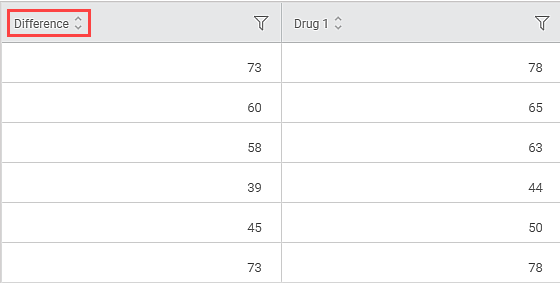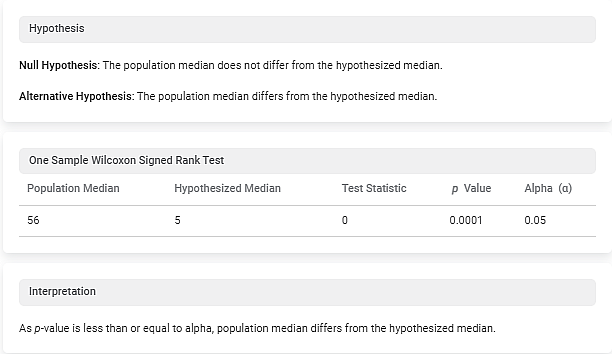Description |
| ||
Why to use | To determine if a single group differs significantly from a known or a hypothesized value. | ||
When to use |
| When not to use |
|
Prerequisites |
| ||
Input | Numeric dataset | Output |
|
Statistical Methods Used |
| Limitations | If the values of many data entries are the same, the test may produce incorrect results. |
One Sample Wilcoxon Signed Rank Test is located under Model Studio () in Statistical Analysis below Hypothesis Test, under Non-Parametric Test in the left task pane. Use the drag-and-drop method or double-click to use the algorithm in the canvas. Click the algorithm to view and select different properties for analysis. You can access it using the search option.
The system calculates the p value in this test and compares it with the alpha value.
Criteria | Interpretation |
|---|---|
When the p-value is greater than alpha an alternative hypothesis can either be "Two-sided" or "One-sided (less than)" or "One-sided (greater than)". | As the p-value is greater than alpha, the population median does not differ from the hypothesized median. |
When the p-value is less than or equal to alpha and the alternative hypothesis is equal to" Two-sided". | As the p-value is less than or equal to alpha, the population median differs from the hypothesized median. |
When the p-value is less than equal to alpha and the alternative hypothesis is equal to "One-sided(less than)". | As the p-value is less than or equal to alpha, the population median is less than the hypothesized median. |
When the p-value is less than equal to alpha and the alternative hypothesis is equal to "One-sided (greater than)". | As the p-value is less than or equal to alpha, the population median is greater than the population median hypothesized median. |
Properties of One Sample Wilcoxon Signed Rank Test
The available properties of the One Sample Wilcoxon Signed Rank Test are shown below.
The table below describes the different properties of the One Sample Wilcoxon Signed Rank Test.
Field | Description | Remark | |
|---|---|---|---|
Task Name | It is the name of the task selected on the workbook canvas. |
| |
Features | It allows you to select the independent variable. |
| |
Advanced | Hypothesized mean | It is the value that the test uses to determine if the group differs | The default value is 5. You can modify this value. |
Zero Method | Zero difference is a way of telling whether you wish to discard the differences in your data or not. |
| |
Correction |
|
| |
Alpha | It allows you to set the level of significance. |
| |
Alternative | Defines the alternative hypothesis. |
| |
Node Configuration | It allows you to select the instance of the AWS server to provide control over the execution of a task in a workbook or workflow. | For more details, refer to Worker Node Configuration. | |
Example of One Wilcoxon Signed Rank Test
As a medical researcher, you would like to know if a given Drug 1 performs better than the determined level of 5. You use one sample Wilcoxon test to do so.
The data tab shows the selected input column and a new column called Difference which shows the values obtained after subtracting the hypothesized median, which is 5 in this case, from the input column.
Further, the Result page is as follows.
The result page consists of the following sections:
- Hypothesis:
This section displays Null Hypothesis and Alternative Hypothesis defined by the system. - One Sample Wilcoxon Signed Rank Test:
This section displays the One-Sample Wilcoxon Signed Rank test result. It shows a value of the following parameters:- Population Median
- Hypothesized Median
- Test Statistic
- p Value
- Alpha (α)
- Interpretation:
In this example, the p value (0.0001) is less than the alpha value (0.05); hence the null hypothesis is rejected. Thus, in this case, the level of effectiveness of drug 1 is more than 5.
Table of Contents



